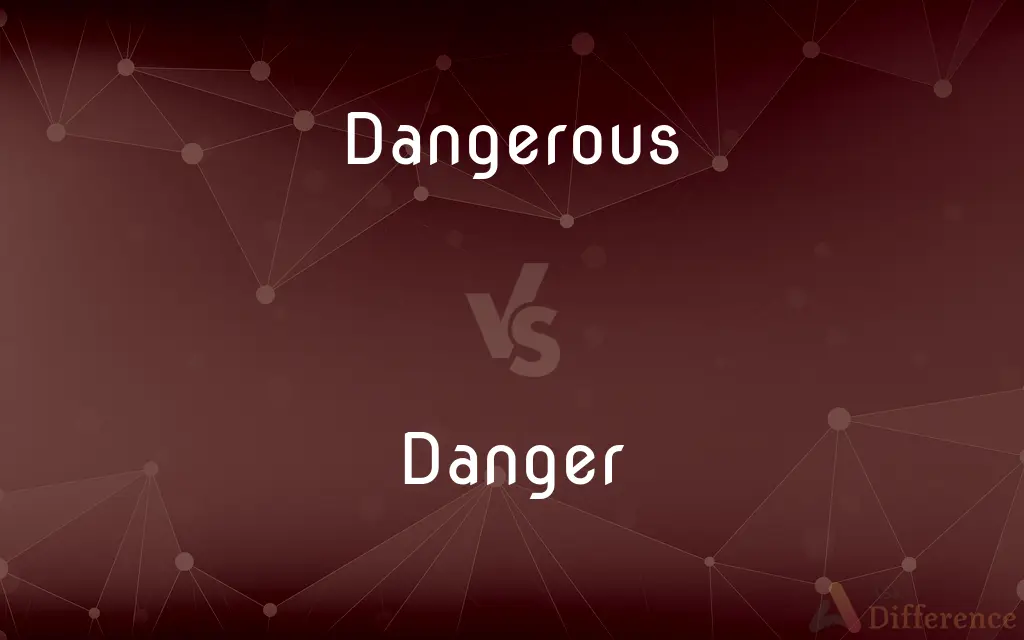Dangerous vs. Danger — What's the Difference?
Edited by Tayyaba Rehman — By Urooj Arif — Updated on March 7, 2024
Dangerous describes something that can cause harm or peril, whereas danger is the potential for harm or peril itself.

Difference Between Dangerous and Danger
Table of Contents
ADVERTISEMENT
Key Differences
Dangerous is an adjective that describes objects, situations, or activities posing a risk of harm or injury. For example, a dangerous chemical has properties that can cause physical damage if not handled correctly. On the other hand, danger is a noun that refers to the presence or imminence of harm. It is the condition or situation where there's a risk involved, such as the danger of falling rocks in a certain area.
While dangerous often applies to something specific that can cause harm, danger refers more broadly to the concept or state where harm is possible. A dangerous animal has the capacity to inflict harm due to its characteristics, whereas being in danger might not always involve a specific source of threat but rather a general state of vulnerability.
In terms of perception, calling something dangerous implies a clear and recognized risk based on its qualities or actions, like a dangerous curve on a road known for accidents. Danger, however, can be more about the potential for harm in a situation or environment, such as the danger presented by walking alone at night in an unfamiliar area.
Regarding response and mitigation, dealing with something dangerous usually involves specific actions to reduce risk, such as wearing protective gear. Addressing danger might involve more general precautions, like avoiding certain areas or conditions known to be hazardous.
The assessment of being dangerous is often based on empirical evidence or known characteristics, such as a toxic substance's effects on health. The concept of danger, however, can also include perceived threats, where the level of risk might be subjectively evaluated or influenced by personal experiences and societal norms.
ADVERTISEMENT
Comparison Chart
Part of Speech
Adjective
Noun
Definition
Describes something that can cause harm.
The potential or actual presence of harm.
Application
Used to qualify objects, activities, or situations.
Refers to a state or condition of being exposed to harm.
Examples
A dangerous virus, a dangerous job
The danger of drowning, the danger of theft
Perception
Involves recognition of specific risks.
Involves awareness of a potential or general risk.
Compare with Definitions
Dangerous
Involving great risk or peril.
They went on a dangerous expedition through the jungle.
Danger
A situation involving exposure to harm.
They were unaware of the danger they were in.
Dangerous
Capable of causing harm or injury.
Handling dangerous chemicals requires special training.
Danger
The threat of damage or loss.
The danger to wildlife in that area is increasing.
Dangerous
Likely to cause problems or adverse effects.
Ignoring the warning signs can be dangerous.
Danger
The possibility of suffering harm or injury.
There's a danger of ice on the roads tonight.
Dangerous
Full of hazards or threats.
The abandoned house is considered dangerous due to its instability.
Danger
A risk or perilous situation.
Walking alone at night poses a danger.
Dangerous
Risky, with potential for negative outcomes.
It's dangerous to drive in such foggy conditions.
Danger
A person or thing that causes fear or anxiety because of potential harm.
That dog is not a danger to people.
Dangerous
Able or likely to cause harm or injury
Insecticides which are dangerous to the environment
A dangerous animal
Danger
The possibility of suffering harm or injury
His life was in danger
Dangerous
Involving or filled with danger; perilous.
Danger
Exposure or vulnerability to harm or risk.
Dangerous
Being able or likely to do harm.
Danger
A source or an instance of risk or peril.
Dangerous
Full of danger.
Railway crossings without gates are highly dangerous.
Danger
(Obsolete) Power, especially power to harm.
Dangerous
Causing danger; ready to do harm or injury.
Danger
Exposure to likely harm; peril.
There's plenty of danger in the desert.
Dangerous
Attended or beset with danger; full of risk; perilous; hazardous; unsafe.
Our troops set forth to-morrow; stay with us;The ways are dangerous.
It is dangerous to assert a negative.
Danger
An instance or cause of likely harm.
Dangerous
Causing danger; ready to do harm or injury.
If they incline to think you dangerousTo less than gods.
Danger
(obsolete) Mischief.
Dangerous
Hard to suit; difficult to please.
My wages ben full strait, and eke full small;My lord to me is hard and dangerous.
Danger
The stop indication of a signal (usually in the phrase "at danger").
The north signal was at danger because of the rockslide.
Dangerous
Reserved; not affable.
Danger
(obsolete) Ability to harm; someone's dominion or power to harm or penalise. See in one's danger, below.
Dangerous
Involving or causing danger or risk; liable to hurt or harm;
A dangerous criminal
A dangerous bridge
Unemployment reached dangerous proportions
Danger
(obsolete) Liability.
Dangerous
Causing fear or anxiety by threatening great harm;
A dangerous operation
A grave situation
A grave illness
Grievous bodily harm
A serious wound
A serious turn of events
A severe case of pneumonia
A life-threatening disease
Danger
(obsolete) Difficulty; sparingness; hesitation.
Danger
(obsolete) To claim liability.
Danger
(obsolete) To imperil; to endanger.
Danger
(obsolete) To run the risk.
Danger
Authority; jurisdiction; control.
In dangerhad he . . . the young girls.
Danger
Power to harm; subjection or liability to penalty.
You stand within his danger, do you not?
Covetousness of gains hath brought [them] in dangerof this statute.
Danger
Exposure to injury, loss, pain, or other evil; peril; risk; insecurity.
Danger
Difficulty; sparingness.
Danger
Coyness; disdainful behavior.
Those rich man in whose debt and danger they be not.
Danger
To endanger.
Danger
The condition of being susceptible to harm or injury;
You are in no danger
There was widespread danger of disease
Danger
A venture undertaken without regard to possible loss or injury;
He saw the rewards but not the risks of crime
There was a danger he would do the wrong thing
Danger
A cause of pain or injury or loss;
He feared the dangers of traveling by air
Danger
A dangerous place;
He moved out of danger
Common Curiosities
Can a situation be dangerous without immediate danger?
Yes, a situation can be considered dangerous if it has the potential to become harmful even if there is no immediate danger.
How do I know if something is dangerous?
Something may be deemed dangerous based on past incidents, known properties, or official warnings.
Is danger subjective?
Perceptions of danger can vary between individuals based on experience and tolerance for risk.
How is danger communicated?
Danger is often communicated through signs, warnings, or instinctual feelings of fear and anxiety.
Is danger always visible?
No, danger is not always visible; it can be hidden or not immediately apparent.
What makes something dangerous?
Something is considered dangerous if it has the capability to cause harm or poses a significant risk.
Is it possible to live without any danger?
Living completely without any danger is unlikely due to the inherent risks present in the environment and daily activities.
Can danger be avoided?
While not all dangers can be completely avoided, risks can often be minimized through awareness and precautionary measures.
Does dangerous always imply immediate harm?
Not necessarily; something dangerous has the potential to cause harm, which may not be immediate.
Can technology help in identifying dangerous situations?
Yes, technology can aid in identifying dangerous situations through monitoring, alerts, and providing safety information.
How does society deal with dangerous individuals or entities?
Society deals with dangerous individuals or entities through laws, regulations, and safety measures designed to protect the public.
Can something be dangerous for one person but not another?
Yes, depending on individual vulnerabilities, something might be dangerous for one person but not for another.
Are all dangers obvious?
No, some dangers may not be immediately obvious and can be hidden or unexpected.
How do people generally react to danger?
Reactions to danger vary but often include avoidance, preparation for defense, or seeking safety.
What role does education play in recognizing danger?
Education can significantly improve the ability to recognize and respond appropriately to danger.
Share Your Discovery

Previous Comparison
Elastic vs. Plastic
Next Comparison
Off vs. OfAuthor Spotlight
Written by
Urooj ArifUrooj is a skilled content writer at Ask Difference, known for her exceptional ability to simplify complex topics into engaging and informative content. With a passion for research and a flair for clear, concise writing, she consistently delivers articles that resonate with our diverse audience.
Edited by
Tayyaba RehmanTayyaba Rehman is a distinguished writer, currently serving as a primary contributor to askdifference.com. As a researcher in semantics and etymology, Tayyaba's passion for the complexity of languages and their distinctions has found a perfect home on the platform. Tayyaba delves into the intricacies of language, distinguishing between commonly confused words and phrases, thereby providing clarity for readers worldwide.
















































